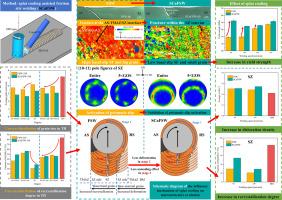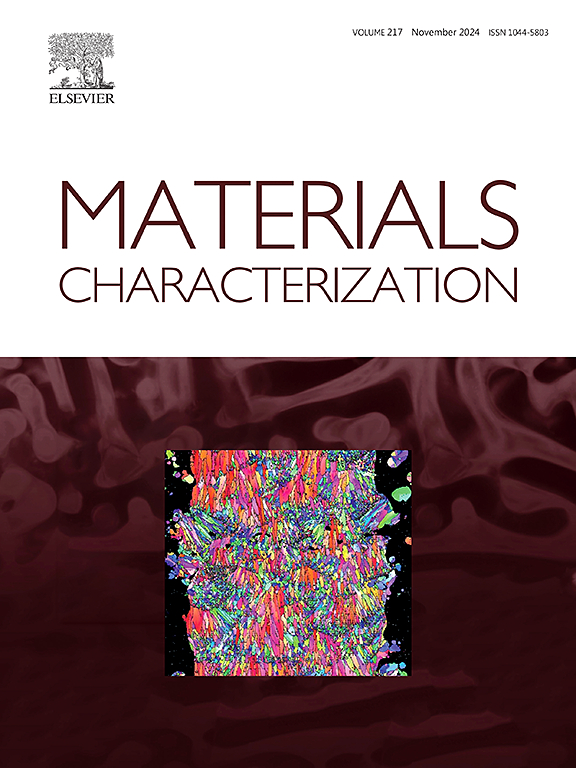揭示飞溅冷却对搅拌摩擦焊接 ZK61M 镁合金微观结构演变和力学性能的影响机理
IF 4.8
2区 材料科学
Q1 MATERIALS SCIENCE, CHARACTERIZATION & TESTING
引用次数: 0
摘要
在搅拌摩擦焊(FSW)过程中应用冷却辅助能有效提高接头的屈服强度,从而使焊缝两侧的母材产生更多应变,抑制接头应变局部化,达到同时提高接头强度和韧性的效果。然而,目前对镁合金冷却辅助 FSW 的研究有限,尤其是对 ZK 系列镁合金。因此,本研究对 ZK61M 镁合金进行了传统 FSW 和新型飞溅冷却辅助搅拌摩擦焊(SCaFSW)。研究发现,采用飞溅冷却会略微增加横向力、减少搅拌区(SZ)面积并细化晶粒尺寸。以 60 毫米/分钟的焊接速度进行飞溅冷却后,接头的极限拉伸强度(UTS)从 210.4 兆帕增至 257.1 兆帕,接头效率达到 90.7%。接头的屈服强度(YS)也有所提高,从 138.6 兆帕提高到 185.0 兆帕,提高了 33.4%,这可归因于晶粒尺寸和基底滑移施密德因子(SF)的减少。当采用溅射冷却时,由于新形成的剪切带对沉积剪切带的变形效应减弱,大量再结晶晶粒得以保留。同时,退火效应的减弱导致保留了更多的位错结构。最终,在 SCaFSW 接头中,再结晶程度和位错密度可同时提高。研究结果表明,采用溅射冷却是改善 FSW ZK 系列镁合金接头性能的有效方法。本文章由计算机程序翻译,如有差异,请以英文原文为准。

Unveiling the influence mechanism of splat cooling on the microstructure evolution and mechanical properties of friction stir welded ZK61M magnesium alloy
The application of cooling assistance during the friction stir welding (FSW) process can effectively improve the yield strength of the joint, thereby causing more strain to occur in the base material on both sides of the weld seam, inhibiting strain localization in the joint, and achieving the effect of simultaneously improving the strength and toughness of the joint. However, there are currently limited studies on cooling-assisted FSW of magnesium alloys, especially for ZK series magnesium alloys. Therefore, conventional FSW and novel splat cooling assisted friction stir welding (SCaFSW) were carried out on ZK61M magnesium alloy in this study. It was found that the application of splat cooling slightly increases the traverse force, reduces the area of the stir zone (SZ) and refines the grain size. After applying splat cooling at a welding speed of 60 mm/min, the ultimate tensile strength (UTS) of the joint increased from 210.4 MPa to 257.1 MPa, achieving a joint efficiency of 90.7 %. The yield strength (YS) of the joint also improved, rising from 138.6 MPa to 185.0 MPa, representing a 33.4 % improvement, which can be attributed to the reduction in grain size and basal slip Schmid factor (SF). When splat cooling is applied, due to the weakened deformation effect of the newly formed shear band on the deposited shear band, a large number of recrystallized grains are preserved. At the same time, the reduced annealing effect leads to the retention of more dislocation structures. Ultimately, both the degree of recrystallization and dislocation density can be simultaneously increased in the SCaFSW joint. It revealed that the application of splat cooling is an effective method for improving the joint properties of FSWed ZK series Mg alloy.
求助全文
通过发布文献求助,成功后即可免费获取论文全文。
去求助
来源期刊

Materials Characterization
工程技术-材料科学:表征与测试
CiteScore
7.60
自引率
8.50%
发文量
746
审稿时长
36 days
期刊介绍:
Materials Characterization features original articles and state-of-the-art reviews on theoretical and practical aspects of the structure and behaviour of materials.
The Journal focuses on all characterization techniques, including all forms of microscopy (light, electron, acoustic, etc.,) and analysis (especially microanalysis and surface analytical techniques). Developments in both this wide range of techniques and their application to the quantification of the microstructure of materials are essential facets of the Journal.
The Journal provides the Materials Scientist/Engineer with up-to-date information on many types of materials with an underlying theme of explaining the behavior of materials using novel approaches. Materials covered by the journal include:
Metals & Alloys
Ceramics
Nanomaterials
Biomedical materials
Optical materials
Composites
Natural Materials.
 求助内容:
求助内容: 应助结果提醒方式:
应助结果提醒方式:


